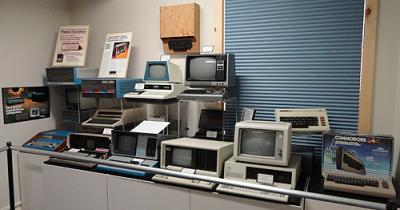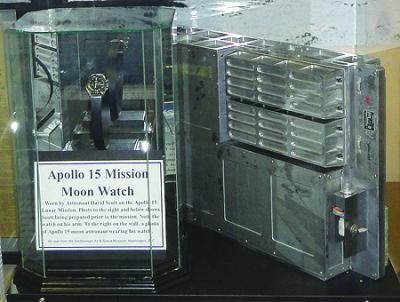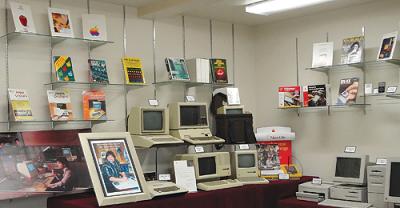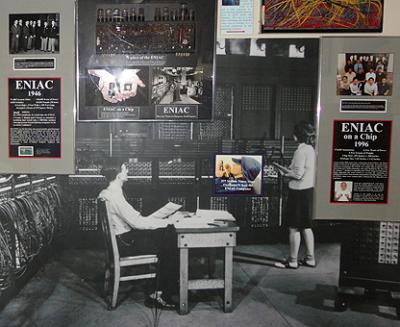Byte of Bozeman
American Computer Museum

What to do in Montana...
In the heart of Bozeman within sight of the MSU stadium there is a place where past and future converge, where in the space of an hour or two one can learn the history of computing from the abacus to the iPad. Here the earliest methods used to keep count are displayed alongside original documents, artifacts and examples of technological developments from their beginnings to the present. The result is a comprehensive history of the information age. Every inch of the 2,000 square feet that comprise The American Computer Museum provides an insight into a subject, which on the surface may seem mundane but underneath provides a wealth of fascinating information, much of it pertinent to our daily lives.
Renowned Harvard biologist Edward O. Wilson, an annual visitor to Bozeman since he received the Museum’s prestigious Stibitz Award in 2006, maintains that, “Inch for inch, (it is) the best museum in the world.” And because it is one of only three existing, and the most comprehensive of those, travelers come to Montana from all over to visit it. The companion museums are the Heinz Nixdorf in Paderborn, Germany, and the Computer History Museum in Mountain View, California. Neither has the depth of focus nor the wealth of historical documents to be found in the Bozeman museum where about 6% of the inventory is on display at any one time.

Recently, a Japanese film company requested permission to visit and video in the museum for Japanese television. Since director George Keremedjiev was out of town attending to his profession as a manufacturing consultant, his wife, Barbara, suggested that they go instead to Mountain View where the display area is 12 times the size and the budget much larger. The Japanese company representative replied, “Yours is the museum we want to feature.” When the crew arrived, Barbara enlisted former Stibitz Award winner Maury Irvine to show them around. Maury is among four of the Stibitz (1997-2006) and E. O. Wilson Award (2006-onward) recipients who live in Bozeman: the other three are Klein Gilhousen (2002), David Quammen (2010) and David Ward, MSU biologist (2010).
George and Barbara Keremedjiev, founders and overseers of the museum, are a valiant team who opened their private collection to the public in May 1990. The Stadium Drive is their third address. The museum is public, not private as is sometimes thought. It is a 501(c)(3) nonprofit corporation that depends entirely on patrons’ contributions. It is not affiliated with the university or any other entity although it has a classroom where MSU seminars are held. The space is also available for suitable events.

The latest exhibition, which opened in January 2012, is called Steve and Steve. Unsurprisingly, these are Wozniak and Jobs. It is the most comprehensive exhibit of the Apple Company history on display anywhere to date. There is an iconic photograph taken in 1975 of the pair in Jobs’ bedroom at his parent’s home in Los Altos, California. It was there that they first assembled the Apple 1 computer. Next to it hangs a photo of the proverbial garage of the same house, where the 200 Apple1 computers were packaged for shipping in 1976. It was the “first low cost micro computer” with a price tag of $666.66. Only 40 Apple 1 computers remain and one of those can be seen at the museum. It was a gift from Steve Wozniak who came to Bozeman in 2000 to accept the Stibitz Award for inventing the Apple 1 and II and for co-founding the Apple Computer Company. In 1976 he went into partnership with Jobs, five years his junior. They had first met in Cupertino, California, when they were 21 and 16 years respectively. Jobs dismissed their age discrepancy explaining: “I was a little more mature and he a little less mature, so it evened out.” “Woz,” as he prefers to be called, pioneered the concept of a truly personal computer: Jobs directed the design and marketing of the Apple. Woz excelled at engineering designs. Jobs provided the artistic standards. Sadly, Jobs died of pancreatic cancer on October 5, 2011.
At their first meeting in 2000 an immediate friendship developed between Wozniak and the Keremedjievs. He returned to Bozeman in 2002 to deliver the keynote speech at the annual Stibitz Award. Woz made two substantial donations to the museum. He asked if there was anything he could give besides money. George requested an Apple 1 computer. It is one of the most valuable items in the museum.

While I was browsing the Steves exhibit, I overheard a visitor say, “I came here because I was interested in seeing things in a museum that are used every day.” An excellent point, but possibly the reason why many people don’t come. The human element of the technology story is evident in the eight interconnected rooms. “Behind every invention is a human being,” Barbara Keremedjiev tells a visitor. Each room, chock full of surprises, unfolds a story that is as old as recorded history. It was that narrative quality of the museum that Dr. Edward O. Wilson found so attractive.
As we toured the rooms George emphasized that technology has made it possible for many people to live and work in Montana. Business can be done long distance with the aid of a computer and smart phone. Then he pointed out surprising connections with the past. For instance, in the markets of the ancient world the counter sat at a table. Buyers brought their purchases to him and he tallied the cost. The table and the man were known as “the counter.” It is the same word we use in our shops and kitchens today.

Four years ago my son, a curator in the Ancient Greek and Roman Department of the Metropolitan Museum in New York, visited Bozeman for Thanksgiving. He asked me urgently if he could visit The American Computer Museum. “I must see the Antikythera Mechanism. It is the only chance I’ll have to view it in the United States.” Keremedjiev confirmed that he commissioned the replica of the world’s earliest surviving computer from an orrery maker in London in 2002. None other is on public display in the Western Hemisphere. However, the mangled remains of the original (from 80 B.C.) can be seen at the National Archaeological Museum in Athens.
As we stood in front of the life-sized reproduction of the Gutenberg Press which Joannes Gensflaisch zur Laden Gutenberg assembled using a wine press design in Germany in the mid-15th century, George observed that the introduction of the iPad was as revolutionary in the field of communications in our own century as Gutenberg’s press was in the 15th. Before 1455 there were thirty thousand books in Europe, mostly written by hand by scribes, each taking one year to complete. In 1499 there were twenty million books. It was a revolution equal to the one we enjoy with technology today.
Recently, when I asked Maury Irvine how he would describe The American Computer Museum, he said, “Nowhere else can one find, under one roof, artifacts ranging from original 4500 year old Babylonian clay tablets to an original NASA Apollo Moon Mission Navigational Computer, from a replica of a 2,100-year-old geared computer to an iPad. The history of communicating and computing is all here. Even an original Pony Express mail bag.” There you have it.
Leave a Comment Here
Leave a Comment Here